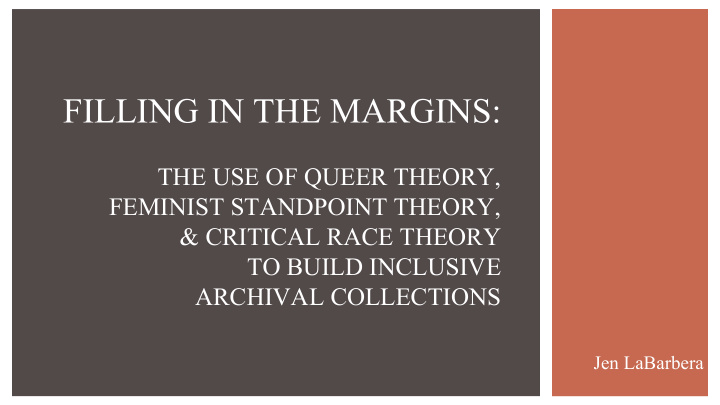



FILLING IN THE MARGINS: THE USE OF QUEER THEORY, FEMINIST STANDPOINT THEORY, & CRITICAL RACE THEORY TO BUILD INCLUSIVE ARCHIVAL COLLECTIONS Jen LaBarbera
THEORETICAL FRAMEWORK critical race theory queer theory feminist standpoint theory
RESEARCH QUESTIONS ● What type of theoretical approaches do archivists use to build inclusive archives? ● Do archivists already apply principles of critical race theory, feminist standpoint theory, or queer theory in their collection development work? ● What does it look like when these theoretical frameworks are applied to archival practice? ● What challenges do archivists identify that may be alleviated by the application of a combination of feminist standpoint theory, queer theory, and critical race theory to archival practice?
DATA ANALYSIS: CODING SCHEMA
DATA ANALYSIS: CODING SCHEMA
RESULTS ● all interviewees exhibited some characteristics of each theoretical framework in their descriptions of their approaches to the work ● each interviewee also identified challenges that a more intentional application of this combined theory could alleviate
REFLEXIVITY ◼ “Especially from marginalized groups. In my CODES: opinion, our society - the predominantly white ● Acknowledging & Naming community - has done a lot of taking, and we Privilege (CRT / FST) need to give back. I think that that also helps in the relationship-building process, to be clear that ● Acknowledging & Naming Position (FST) we’re not here to take, we’re here to work with you and we’re here to do what’s best for you and ● Prioritizing & Naming Difference (QT / CRT) for the materials. So that’s sort of the approach that I try to take when I work with new people or ● Centering people of color organizations.” and marginalized groups (CRT)
STORYTELLING CODES: ◼ “Well, there’s so much that’s not in the written record or the traditional record. As I said before, we thought that ● Storytelling as revising maybe some of these - Some people do not save material, history (CRT) as in papers, but they have an important story to tell, and that’s one reason for oral history. Another is that you get ● Acknowledging & prioritizing the knowledge a very different kind of information in oral histories than of marginalized groups you get in the written record, especially if the written (FST) record is more official or it’s more the everyday work ● Redefining (materials, records or council records or something like that. If you practices, categories) (QT) get an oral history, that really enriches the record of both. And you need both of those kinds of records.”
TRUST & RELATIONSHIP-BUILDING CODES: ◼ “...marginalized groups may be more skeptical of a predominantly white institution wanting their ● Donors/Archivists as Participants (QT/FST) records. So that’s part of the building in the ● Identifying & Naming relationship and also as you know it’s a challenge Privilege (CRT / FST) for archives to have people know about what ● Acknowledging & archiving is anyway - any groups, it can be Naming Position (FST) challenging to explain what we do - so that’s with almost any community, of having to go in and explain what an archive is and what we do and all of that.”
IMPLICATIONS FOR PRACTICE A more intentional application of queer theory, critical race theory, and feminist standpoint theory can help to alleviate some of the challenges identified by archivists working to build inclusive collections: ● selection and appraisal ● trust-building and relationship-building ● redefining archival collections
QUESTIONS? jen.labarbera@gmail.com @jenlabarbera
Recommend
More recommend